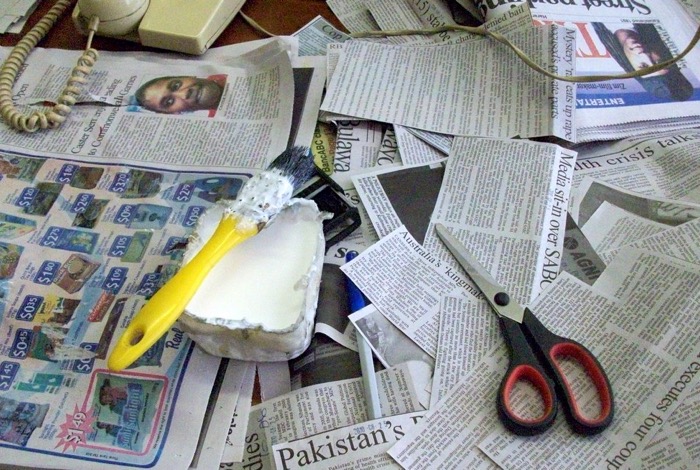
Journalism is a continuous process of updating and revising news stories, because any published news item is likely to become outdated rapidly.
So as soon as journalists publish anything in print, online or on air, the information we deliver is likely to be out of date.
I started my career in journalism as a newspaper reporter. In the corner of the newsroom there was a desk with a pair of scissors and a pot of glue.
You can see the sort of set up in the image above. The photograph was taken in the newsroom of The Chronicle in Bulawayo, Zimbabwe, where I was doing some journalism training in 2010.
The scissors are for cutting out articles from the day’s newspaper. The glue is for sticking them on a sheet of paper with the date and key words at the top. They were then filed in boxes stored on massive shelves. This was the newspaper’s archive. Every new story covered would involve a visit to the archive for background and context.
The same was true at my first newspaper, The Southport Visiter (correct spelling). We had a ‘diary-and-file’ area where our cuttings were kept. There was a line of metal filing cabinets with alphabetically-labelled drawers. Then there was the diary, a shared book where all important follow-up dates had to be recorded.
It was every reporter’s responsibility to ‘diary-and-file’ their work.
This indicates two things. The daily newspaper is – as soon as it comes off the printing press – archive material. But it’s also essential material for background information. It’s a document of record that will provide valuable information in the future.
At the BBC we had department called News Information where journalists could order background information from a huge archive. All was old news, but it was also valuable news when it came to piecing together an update or covering a breaking or developing story about a topic that had been in the news previously. It was essential for adding context.
My first job at the BBC was on the local radio station in my hometown of Liverpool, England. A few weeks after working as a reporter, getting out and about covering news stories and interviewing locals, I was asked to compile and read my first news bulletin.
I thought it went well and returned to the newsroom feeling quite proud of myself. I was about to make a cup of tea, sit down and put my feet up when the news editor came over and told me to rewrite everything. “We don’t deal in old news,” he said.
Even wonderfully-crafted parts of my script that I felt couldn’t be improved had to be refreshed. I was struggling to think of any ways to update the material as the next hourly news bulletin approached.
My news editor, Ken, told me to get up. He sat in my chair, took over my typewriter (we didn’t have computers in those days), and, with a cigarette hanging from the corner of his mouth, refreshed the whole five-minute news script in what seemed like seconds.
I was told to put in fresh calls to find out new information. It wasn’t as big a deal as I thought. But it was essential work. The next bulletin was fresh, relevant, and, most importantly updated.
The lesson forced me to think through all the elements in the story and how they could be developed. It forced me to be a journalist and not just a news reader.
Radio bulletin checklist 1981
There was a checklist for tasks at Liverpool’s Radio Merseyside in 1981.
- Write bulletin and underline any facts in the story that need to be checked for updates
- Rewrite the bulletin immediately after leaving the studio and before thinking about making a cup of tea
- The rewriting should include both the introduction script and the piece itself
- If necessary, get any audio reports re-voiced if the information is out-of-date
- If you are using an audio clip of someone in the news always have a selection of at least three alternatives available, one talking about what has happened, another about what they intend to do about it, and the third about what will happen next
- Never run a voiced report or an audio clip more than three times, which would include the main morning, lunchtime or evening bulletins.
- Realise that all those mentioned in the news bulletin may have fresh information to share after having heard your bulletin. It would be amazing if they didn’t. Call them and see what’s changed
- Make a note of all the times and dates mentioned in the bulletin to ensure the newscast is not dated
- Put in another round of calls to police, fire, ambulance and anyone who features in a developing news story, such as union leaders, bosses, councillors, activists, sports personalities etc
In other words, never repeat a bulletin hour after hour. It’s almost certain that, if you do, you will be delivering old news and the motto was that old news is no news.
Discipline of updating stands test of time
We had a similar philosophy when we launched BBC News Online in 1997. We were continually checking for new developments, updating stories, and republishing the site.
The early training in print and broadcast that most of us had gone through in that BBC online newsroom had prepared us well for the BBC’s first move into 24-hour rolling news.
It’s interesting how some of those basic principles of journalism best practice appear to be timeless.
And now we have the luxury of a steady stream of updates online via social media and on news sites that provide live coverage of events with story formats that see the coverage grown chronologically.
The problem with that format is that the longer the update grows, the further the reader is from the original source of the material, making it harder to read the context behind the development/event.
This is particularly true with social media where emotional and subjective reactions to the original news take on a life of their own.
With rolling updated stories on the main news sites there is a need to continually provide links back to the original story so those following events can better understand where, why, and how the news item first broke.
Otherwise we can easily fall into the post-truth trap where emotional responses to events take over the events themselves. Facts get lost in the quick fire responses, and the chatter and noise of ill-informed reaction takes on a life of its own and eventually becomes more amplified than the original incident that began the news process.
Which means that journalists have a responsibility to continually rework and update our news so that all the new elements (reactions and new perspectives) are included while also ensuring that the essential facts that began the news flow are not forgotten but are also included and updated where necessary.








